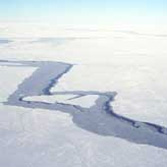Ridging and Rafting
Structural analysis of ice cores from the Antarctic pack indicate that the dynamic processes of rafting and ridging have a major role in the development of Antarctic sea ice, and an important influence on the sea ice thickness distribution. Rafting and ridging occur when floes converge and collide as a result of the differential drift of individual floes.
The rafting of floes in their early stages of development is often responsible for the rapid thickening of floes to about 0.4 - 0.6 m. It is predominantly through rafting that nilas develops into young ice and how small pancakes bond together to form larger floes. Further convergence of floes once they have reached this thickness is more likely to result in the breaking and stacking of floes to form pressure ridges.
Analysis of the pack shows that deformation, rather than basal freezing, is the dominant mechanism for increasing ice thickness beyond 0.2-0.4 m. This results in an increase in local ice thickness whilst at the same time opening leads where, during the growth season, new ice is able to form. The net effect is increased ice production resulting in an increase in the total mass of ice within the pack, and subsequent changes in the ice thickness distribution.
An estimate of the areal extent and height of ridging is included in the routine sea ice observations made from ships, as ridged areas contain a disproportionately large percentage of ice mass per unit area. For example, data collected on eight voyages into the East Antarctic pack showed that when the ridged areas are taken into account, on average the mean ice thickness increases by 1.7 times the observed mean undeformed ice thickness. As the total ice volume is the key parameter for determining the amount of salt rejected from the ice during the growth season, and the amount of fresh water released during the melt season, any estimate of average ice thickness needs to incorporate the contribution of ridges.

